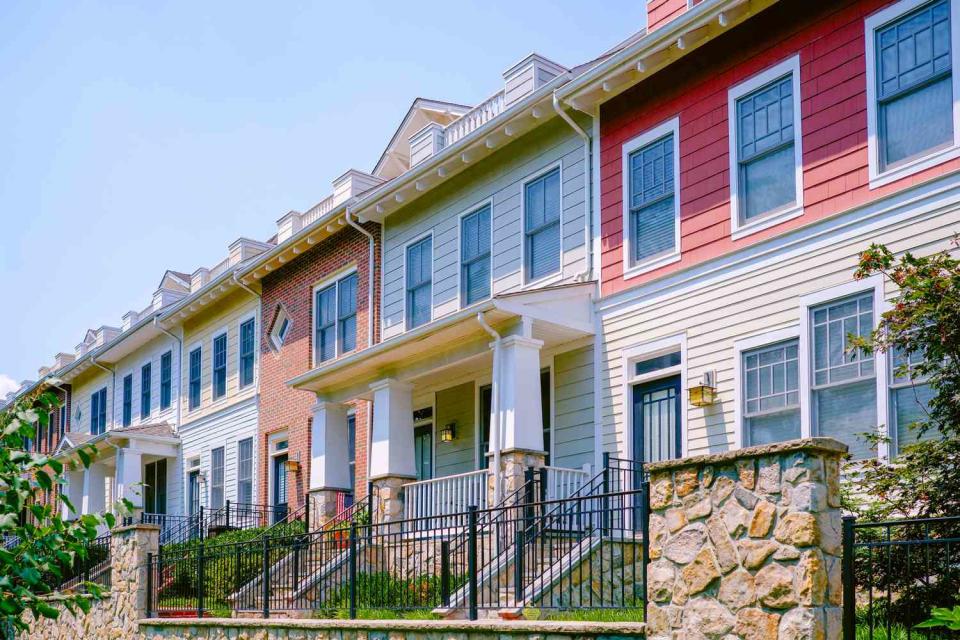What an Attached Family Home Is—and What to Know Before You Buy One
Also known as a townhouse or row house, attached family homes can be a great choice for any home buyer—but you need to be aware of a few things first.

Grace Cary / Getty Images
If you’re shopping for a new home, you’ve probably noticed terms such as single-family home and duplex used in property listings, and you’ve probably figured out exactly what those home types are—but do you know how attached family homes fit into the picture? Attached family homes, also called townhouses, are homes that often share a wall and are typically designed as a row of houses.
“They are different from multi-family units in that they often don’t have units below or above them,” says Courtney Klosterman, home insights expert at Hippo, a home insurance company.
Like all home types, attached family homes have their pros and cons. Read on for expert tips on what to look for if you’re in the market for an attached family home or townhouse.
What Is an Attached Family Home?
Attached family homes cover a few types of housing you’ve likely heard of. This includes row houses, townhomes, and even duplexes, technically.
“Duplexes and row homes are also attached homes because they inherently share a wall with a neighbor,” says Libby Levinson-Katz, a broker at Kentwood Real Estate as well as chair of the Market Trends committee at Denver Metro Association of Realtors (DMAR). “Duplexes share one wall with a neighbor, whereas a row home typically shares two walls with neighbors, unless you are at the end of the row.”
Where these homes differ from something like a condo or apartment is typically in how they are treated as part of the larger community of homes.
“Duplexes and row homes are different than an apartment or condo because they have a private entrance, as opposed to a shared entrance and lobby,” Levinson-Katz says.
This type of housing isn’t as common as single-family homes in some regions, though in more crowded areas, they’re very popular.
“Attached homes are traditionally found in large cities with higher density. For example, attached homes are more common in New York City than Cheyenne, Wyoming,” Levinson-Katz says.
:
The Pros of Owning an Attached Family Home
If you’re on a budget or buying your first home, an attached family home is a great option.
“An attached family home generally has a lower purchase price and requires less maintenance than a single-family home in the same area,” Klosterman said. “They can be a good option for young families who are looking to take on the responsibility of owning a home and want to build equity without the larger investment often required of a single-family home.”
Klosterman points out that older households looking to downsize might also find that attached family homes are a good option.
Because attached family homes share walls, you can sometimes benefit on utility costs.
“Attached family homes can be incredibly beneficial from an energy standpoint, as the number of walls shared with a neighbor increases insulation from outside elements, which can be helpful during cold winter nights,” Levinson-Katz says.
Many owners like that they easily mingle with neighbors, too.
“They often create an instant community feel with neighbors close by,” Levinson-Katz says.
And many attached family homes are part of a homeowners association (HOA), which may offer certain maintenance included with ownership.
:
The Potential Downsides of an Attached Family Home
Of course, there are some cons to living in townhouses.
“An attached family home generally has less space, privacy, and freedom to make changes to the home, compared to a single-family home,” Klosterman says. “Sharing walls with other homeowners can also complicate who’s responsible for things like water leaks that impact both homes.”
And while there is typically less maintenance, it comes at a cost.
“It’s important to keep in mind that attached homes in a community generally require the owners to be part of a HOA that can add benefits and amenities, but also will include a monthly fee beyond the mortgage,” Klosterman says. “All HOAs are different, so it’s important to find out what the monthly fee is and what it covers.”
HOAs generally cover exterior maintenance and lawn care. Some also include the cost of utilities such as water and trash, but be sure to check.
The owner will still be responsible for many of the things you’re required to maintain in a single-family home: HVAC, electrical, appliances, etc. As long as you’re clear on which parts of the home are your responsibility, you’ll be set up for success within an attached family home.
“Understand who is responsible—HOA, owner—for the exterior of your home, such as the roof and siding,” Klosterman says. “Oftentimes, a roof leak can impact your home and your neighbors. It is important to understand who is responsible for the repairs to prevent the stress of how to handle unanticipated costs.”
:

